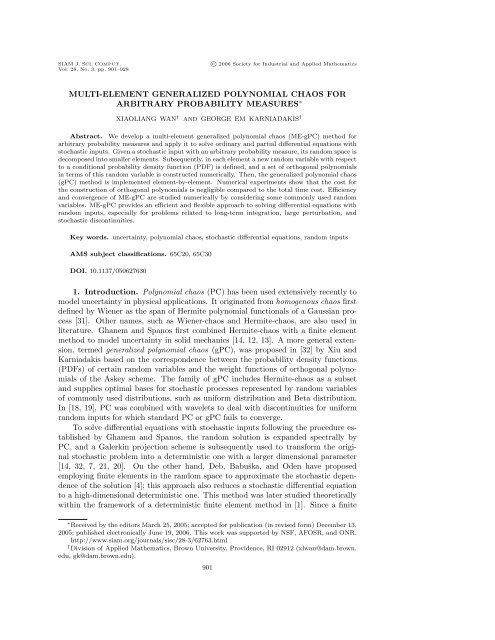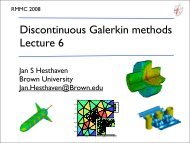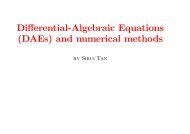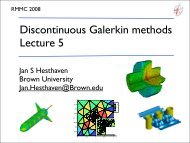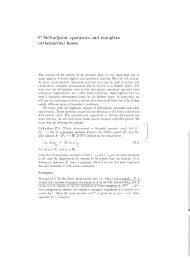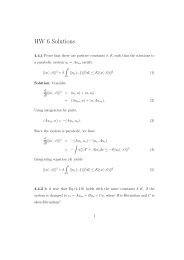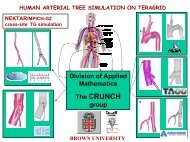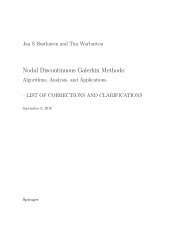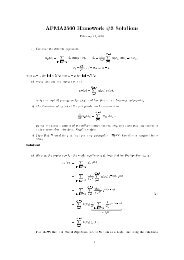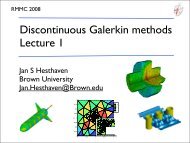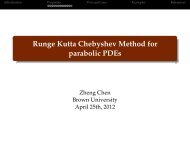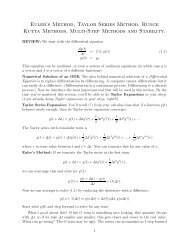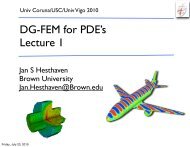MULTI-ELEMENT GENERALIZED POLYNOMIAL CHAOS FOR ...
MULTI-ELEMENT GENERALIZED POLYNOMIAL CHAOS FOR ...
MULTI-ELEMENT GENERALIZED POLYNOMIAL CHAOS FOR ...
Create successful ePaper yourself
Turn your PDF publications into a flip-book with our unique Google optimized e-Paper software.
SIAM J. SCI. COMPUT. c○ 2006 Society for Industrial and Applied Mathematics<br />
Vol. 28, No. 3, pp. 901–928<br />
<strong>MULTI</strong>-<strong>ELEMENT</strong> <strong>GENERALIZED</strong> <strong>POLYNOMIAL</strong> <strong>CHAOS</strong> <strong>FOR</strong><br />
ARBITRARY PROBABILITY MEASURES ∗<br />
XIAOLIANG WAN † AND GEORGE EM KARNIADAKIS †<br />
Abstract. We develop a multi-element generalized polynomial chaos (ME-gPC) method for<br />
arbitrary probability measures and apply it to solve ordinary and partial differential equations with<br />
stochastic inputs. Given a stochastic input with an arbitrary probability measure, its random space is<br />
decomposed into smaller elements. Subsequently, in each element a new random variable with respect<br />
to a conditional probability density function (PDF) is defined, and a set of orthogonal polynomials<br />
in terms of this random variable is constructed numerically. Then, the generalized polynomial chaos<br />
(gPC) method is implemented element-by-element. Numerical experiments show that the cost for<br />
the construction of orthogonal polynomials is negligible compared to the total time cost. Efficiency<br />
and convergence of ME-gPC are studied numerically by considering some commonly used random<br />
variables. ME-gPC provides an efficient and flexible approach to solving differential equations with<br />
random inputs, especially for problems related to long-term integration, large perturbation, and<br />
stochastic discontinuities.<br />
Key words. uncertainty, polynomial chaos, stochastic differential equations, random inputs<br />
AMS subject classifications. 65C20, 65C30<br />
DOI. 10.1137/050627630<br />
1. Introduction. Polynomial chaos (PC) has been used extensively recently to<br />
model uncertainty in physical applications. It originated from homogenous chaos first<br />
defined by Wiener as the span of Hermite polynomial functionals of a Gaussian process<br />
[31]. Other names, such as Wiener-chaos and Hermite-chaos, are also used in<br />
literature. Ghanem and Spanos first combined Hermite-chaos with a finite element<br />
method to model uncertainty in solid mechanics [14, 12, 13]. A more general extension,<br />
termed generalized polynomial chaos (gPC), was proposed in [32] by Xiu and<br />
Karniadakis based on the correspondence between the probability density functions<br />
(PDFs) of certain random variables and the weight functions of orthogonal polynomials<br />
of the Askey scheme. The family of gPC includes Hermite-chaos as a subset<br />
and supplies optimal bases for stochastic processes represented by random variables<br />
of commonly used distributions, such as uniform distribution and Beta distribution.<br />
In [18, 19], PC was combined with wavelets to deal with discontinuities for uniform<br />
random inputs for which standard PC or gPC fails to converge.<br />
To solve differential equations with stochastic inputs following the procedure established<br />
by Ghanem and Spanos, the random solution is expanded spectrally by<br />
PC, and a Galerkin projection scheme is subsequently used to transform the original<br />
stochastic problem into a deterministic one with a larger dimensional parameter<br />
[14, 32, 7, 21, 20]. On the other hand, Deb, Babu˘ska, and Oden have proposed<br />
employing finite elements in the random space to approximate the stochastic dependence<br />
of the solution [4]; this approach also reduces a stochastic differential equation<br />
to a high-dimensional deterministic one. This method was later studied theoretically<br />
within the framework of a deterministic finite element method in [1]. Since a finite<br />
∗Received by the editors March 25, 2005; accepted for publication (in revised form) December 13,<br />
2005; published electronically June 19, 2006. This work was supported by NSF, AFOSR, and ONR.<br />
http://www.siam.org/journals/sisc/28-3/62763.html<br />
† Division of Applied Mathematics, Brown University, Providence, RI 02912 (xlwan@dam.brown.<br />
edu, gk@dam.brown.edu).<br />
901
902 XIAOLIANG WAN AND GEORGE EM KARNIADAKIS<br />
element method is generally used to solve the obtained deterministic PDE system, the<br />
above methods are called stochastic Galerkin finite element methods in [1], while the<br />
scheme in [14, 32] is classified as the p × h version and the scheme in [4] as the k × h<br />
version, where p denotes the polynomial order of PC, k the element size in the random<br />
space, and h the element size in the physical space. Both schemes use finite elements<br />
in the physical space. The p × h version relies on the spectral representation in the<br />
entire random space by PC, while the k × h version is based on the discretization<br />
of the random space using the same basis as the deterministic finite element method<br />
to approximate the random field locally. For simplicity, here we refer to the scheme<br />
in [14, 32] as a PC method of p-version and the scheme in [4] as a k-version. Both<br />
the concepts and the terminology introduced here share similarities with those of the<br />
spectral/hp element method for deterministic problems [17, 25].<br />
In this work, we present a multi-element generalized polynomial chaos (ME-gPC)<br />
method, which can deal with stochastic processes represented by random variables of<br />
arbitrary distributions and achieve kp-convergence in the random space. In the MEgPC<br />
method, we discretize the random space and use a spectral expansion locally<br />
to represent the desired random field. However, the PC basis is, in general, not<br />
orthogonal in a random element since the PDF is also discretized simultaneously. The<br />
only exception is the uniform distribution which has been considered so far in previous<br />
works [14, 4, 32, 28]. To overcome this difficulty, we reconstruct the orthogonal<br />
basis numerically in each random element. From the practical standpoint, it is more<br />
effective to employ a relatively low polynomial order (p =5top = 8) for the ME-gPC<br />
method. Thus, we can do this reconstruction on-the-fly with high accuracy for most<br />
continuous or discrete arbitrary probability measures.<br />
In certain nonlinear stochastic differential equations, random inputs can give rise<br />
to singularities as discussed in [18, 19] or the Kraichnan–Orszag problem [24], where<br />
the gPC method may converge very slowly or even fail to converge. By noting that<br />
singularities usually occur at a lower-dimensional manifold in the random space for<br />
such problems, we aim to “capture” the singular region by random elements related<br />
to a very small probability measure, and implement the gPC method in the regular<br />
region. Hence, the error in the singular region will be dominated by the size (kconvergence)<br />
of the random elements, while the error in the regular region decreases<br />
fast (p-convergence)—possibly exponentially fast. To reduce the total computational<br />
cost, we also present a criterion to implement the decomposition of random space<br />
adaptively.<br />
2. Multi-element generalized polynomial chaos (ME-gPC) method.<br />
2.1. Overview. The original PC was first proposed by Wiener [31]. It employs<br />
the Hermite polynomials in terms of Gaussian random variables as the trial basis<br />
to expand stochastic processes in the random space. According to the theorem by<br />
Cameron and Martin [3] such expansion converges for any second-order processes<br />
in the L2 sense. gPC was proposed in [33] and employs more types of orthogonal<br />
polynomials from the Askey family. It is a generalization of the original Wiener’s<br />
Hermite-chaos and can deal with non-Gaussian random inputs more efficiently.<br />
Let (Ω, F,P) be a probability space, where Ω is the sample space, F is the σalgebra<br />
of subsets of Ω, and P is a probability measure. Let<br />
(2.1)<br />
ξ =(ξ1,...,ξd) :(Ω, F) → (R d , B d )<br />
be an R d -valued continuous random variable, where d ∈ N and B d is the σ-algebra of<br />
Borel subsets of R d . A general second-order random process R(ω) ∈ L2(Ω, F,P) can
e expressed by gPC as<br />
(2.2)<br />
<strong>MULTI</strong>-<strong>ELEMENT</strong> GPC <strong>FOR</strong> ARBITRARY PDF 903<br />
R(ω) =<br />
∞�<br />
âiΦi(ξ(ω)),<br />
i=0<br />
where ω is the random event and Φi(ξ(ω)) denotes the gPC basis of degree p in terms<br />
of the random variable ξ. The family {Φi} is an orthogonal basis in L2(Ω, F,P) with<br />
orthogonality relation<br />
(2.3)<br />
E[ΦiΦj] =E[Φ 2 i ]δij,<br />
where δij is the Kronecker delta and E denotes the expectation with respect to the<br />
probability measure dP (ω) =f(ξ(ω))dω. The index in (2.2) and d ∈ N are, in general,<br />
infinite. In practice, both limits will be truncated at a certain level. For example,<br />
the dimension d of the stochastic input is usually determined by the Karhunen–Loeve<br />
(K-L) expansion based on the decay rate of eigenvalues [14].<br />
For a certain random variable ξ, the orthogonal gPC basis {Φi} can be chosen<br />
in such a way that its weight function has the same form as the PDF f(ξ) ofξ. The<br />
corresponding types of classical orthogonal polynomials {Φi} and their associated<br />
random variable ξ can be found in [32]. In this paper we generalize the idea of gPC<br />
and construct numerically the orthogonal polynomials with respect to an arbitrary<br />
probability measure.<br />
2.2. ME-gPC formulation. We next present the scheme of an adaptive MEgPC<br />
method, which consists of the decomposition of random space, the construction<br />
of orthogonal polynomials, and an adaptive procedure.<br />
2.2.1. Decomposition of random space. We assume that ξ is a random variable<br />
defined on B = × d i=1 [ai,bi], where ai and bi are finite or infinite in R and the<br />
components of ξ are independent identically-distributed (i.i.d.) random variables. We<br />
define a decomposition D of B as<br />
⎧<br />
⎨ Bk =[ak,1,bk,1) × [ak,2,bk,2) ×···×[ak,d,bk,d],<br />
D = B =<br />
⎩<br />
�N k=1 Bk,<br />
(2.4)<br />
�<br />
Bk2 = ∅ if k1 �= k2,<br />
Bk1<br />
where k, k1,k2 =1, 2,...,N. Based on the decomposition D, we define the following<br />
indicator random variables:<br />
IBk =<br />
�<br />
1 if ξ ∈ Bk,<br />
(2.5)<br />
k =1, 2,...,N.<br />
0 otherwise.<br />
Thus, Ω = ∪N k=1I−1(1) is a decomposition of the sample space Ω, where<br />
Bk<br />
(2.6)<br />
I −1<br />
Bi<br />
(1) ∩ I−1(1)<br />
= ∅ for i �= j.<br />
Bj<br />
Given any point q =(q1,q2,...,qd), we use ξ ≤ q to denote ξi ≤ qi for i =1, 2,...,d.<br />
According to the law of total probability, we can obtain<br />
(2.7)<br />
Pr(ξ ≤ q) =<br />
N�<br />
Pr(ξ ≤ q|IBk = 1) Pr(IBk =1).<br />
k=1
904 XIAOLIANG WAN AND GEORGE EM KARNIADAKIS<br />
Using Bayes’s rule, (2.7) implies that we can define a new random variable ξk :<br />
I −1<br />
Bk (1) ↦→ Bk on the probability space (I −1<br />
(1), F∩I−1(1),P(·|IBk<br />
= 1)) subject to a<br />
Bk Bk<br />
conditional PDF<br />
(2.8)<br />
ˆfk(ξ k|IBk =1)=<br />
f(ξk) Pr(IBk =1)<br />
in each random element Bk, where Pr(IBk =1)> 0.<br />
Let u(x,t; ξ) ∈ L2(Ω, F,P) denote a second-order space-time related random<br />
field. For simplicity, we may drop x and t.<br />
Proposition 2.1. Let PM u(ξ) denote the Galerkin projection of u(ξ) onto the<br />
polynomial chaos basis {Φi(ξ)} up to polynomial order M, i =1, 2,...,M.IfPMu(ξ) converges to u(ξ) in the L2 sense with respect to the PDF f(ξ), then PM u(ξk) converges<br />
to u(ξk) in the L2 sense with respect to the conditional PDF ˆ fk(ξk|IBk =1),<br />
k =1, 2,...,N.<br />
Proof. According to the assumption, we know that<br />
E[(u(ξ) −PMu(ξ)) 2 �<br />
]= (u(ξ) −PMu(ξ)) 2 f(ξ)dξ → 0 as M →∞.<br />
By noting<br />
(2.9)<br />
E[(u(ξ) −PM u(ξ)) 2 ]=<br />
we obtain<br />
�<br />
Bk<br />
N�<br />
k=1<br />
B<br />
Pr(IBk =1)<br />
�<br />
Bk<br />
(u(ξ k) −PM u(ξ k)) 2 ˆ fk(ξ k|IBk = 1)dξ k,<br />
(u(ξ k) −PM u(ξ k)) 2 ˆ fk(ξ k|IBk = 1)dξ k → 0 as M →∞,<br />
since both Pr(IBk = 1) and the integrand on the right-hand side of (2.9) are positive<br />
for k =1, 2,...,N.<br />
To this end, we know that there exists a local polynomial approximation for<br />
each random element Bk, which converges in the L2 sense with respect to the local<br />
conditional PDF. For the orthogonal basis {Φi(ξ)} on the entire random space, u(ξ)−<br />
PM u(ξ) is orthogonal to the space V (M,ξ) := span{Φi(ξ) :i ≤ M}. We note here<br />
that although PM u(ξk) converges to u(ξk)intheL2sense within random element<br />
Bk, u(ξk) −PMu(ξk) is not orthogonal to the space V (M,ξk) with respect to the<br />
conditional PDF ˆ fk(·|IBk = 1), since the orthogonality E[ΦiΦj] =δij is, in general,<br />
valid only on the entire random space of ξ with respect to the PDF f(ξ). Due to<br />
the efficiency of orthogonal polynomials in representing stochastic processes, we will<br />
reconstruct the local polynomial chaos modes numerically to make them mutually<br />
orthogonal with respect to the local conditional PDF ˆ f(ξk|IBk = 1). According to<br />
[26, theorem 2.1.1], such an orthogonal polynomial system {Φk,i(ξk)} always exists.<br />
Since in each random element we perform a spectral expansion as in gPC, we call this<br />
method “multi-element generalized polynomial chaos” (ME-gPC).<br />
To approximate a random field u(ξ) using ME-gPC, we expand the random field<br />
spectrally in each element Bk, then reconstruct the entire random field by the following<br />
proposition.
<strong>MULTI</strong>-<strong>ELEMENT</strong> GPC <strong>FOR</strong> ARBITRARY PDF 905<br />
Proposition 2.2. Let ûk(ξ k) be the local polynomial chaos expansion in element<br />
Bk. The approximation on the entire random field can be defined as<br />
(2.10)<br />
u r N�<br />
(ξ) = ûk(ξ)IBk =<br />
N� M�<br />
ûk,jΦk,j(ξ)IBk ,<br />
k=1<br />
k=1 j=0<br />
which converges to u(ξ) in the L2 sense; in other words,<br />
�<br />
(2.11)<br />
Proof. It is easy to see that<br />
�<br />
=<br />
(u<br />
B<br />
r (ξ) − u(ξ)) 2 f(ξ)dξ → 0 as M →∞.<br />
(u<br />
B<br />
r (ξ) − u(ξ)) 2 f(ξ)dξ<br />
N�<br />
k=1<br />
Pr(IBk =1)<br />
�<br />
Bk<br />
(u r (ξ k) − u(ξ k)) 2 ˆ fk(ξ k|IBk = 1)dξ k.<br />
Since ur (ξk)=ûk(ξk) and the spectral expansion ûk(ξk) converges locally in the L2<br />
sense with respect to ˆ f(ξk|IBk = 1), it is clear that the right-hand side of the above<br />
equation goes to zero as M →∞. The conclusion follows immediately.<br />
By Bayes’s rule and the law of total probability, any statistics can be obtained as<br />
(2.12)<br />
�<br />
B<br />
g (u(ξ)) f(ξ)dξ ≈<br />
N�<br />
k=1<br />
Pr(IBk =1)<br />
�<br />
Bk<br />
g (ûk(ξ k)) ˆ fk(ξ k|IBk = 1)dξ k,<br />
where g(·) ∈ L1(Ω, F,P) is a functional of random field u(ξ).<br />
In the appendix, we demonstrate for the interested reader some details on how to<br />
solve PDEs with stochastic coefficients using ME-gPC.<br />
2.2.2. Construction of orthogonal polynomials. We next discuss the numerical<br />
construction of orthogonal polynomials with respect to a conditional PDF<br />
ˆfk(·|IBk = 1). For simplicity, here we discuss only the construction of one-dimensional<br />
orthogonal polynomials, since the high-dimensional basis can be obtained using tensor<br />
products of one-dimensional basis.<br />
It is a distinctive feature of orthogonal polynomials, compared to other orthogonal<br />
systems, that they satisfy a three-term recurrence relation,<br />
(2.13)<br />
πi+1(τ) =(τ − αi)πi(τ) − βiπi−1(τ), i =0, 1,...,<br />
π0(τ) =1, π−1(τ) =0,<br />
where {πi(τ)} is a set of (monic) orthogonal polynomials,<br />
(2.14)<br />
πi(τ) =τ i + lower-degree terms, i =0, 1,...,<br />
and the coefficients αi and βi are uniquely determined by a positive measure, which<br />
corresponds to a probability measure in the construction we propose herein.<br />
For a continuous measure m(τ) there are two classical methods to compute the<br />
recurrence coefficients αi and βi: the Stieltjes procedure and the modified Chebyshev
906 XIAOLIANG WAN AND GEORGE EM KARNIADAKIS<br />
algorithm [8]. The Stieltjes procedure uses the fact that the coefficients αi and βi can<br />
be expressed by the following simple formulas:<br />
(2.15)<br />
and<br />
αi = (τπi,πi)<br />
, i =0, 1, 2,...<br />
(πi,πi)<br />
β0 =(π0,π0), βi = (πi,πi)<br />
,<br />
(πi−1,πi−1)<br />
i =1, 2,...,<br />
(2.16)<br />
where (·, ·) denotes the inner product in terms of the measure m(τ). The above<br />
two formulas together with the recurrence relation (2.13) can be used to calculate<br />
recursively as many coefficients αi and βi as desired.<br />
The modified Chebyshev algorithm is a generalization of the Chebyshev algorithm<br />
[8]. The Chebyshev algorithm relies on the fact that the first n pairs of recurrence<br />
coefficients αi and βi, i =0, 1,...,n− 1, can be uniquely determined by the first 2n<br />
moments μi:<br />
�<br />
μi = τ i (2.17)<br />
dm(τ), i =0, 1,...,2n − 1.<br />
B<br />
Analytical formulas are known which express αi and βi in terms of Hankel determinants<br />
in these moments. However, this algorithm is not reliable for a big n due to<br />
the increasing sensitivity of these formulas to small errors. The modified Chebyshev<br />
algorithm replaces the power τ i with a properly chosen polynomial hi(τ) of degree i:<br />
�<br />
(2.18)<br />
νi = hi(τ)dm(τ), i =0, 1,...,2n − 1.<br />
B<br />
Generally, we can assume that hi(τ) are monic orthogonal polynomials satisfying a<br />
three-term relation<br />
hi+1(τ) =(τ − ˆαi)hi(τ) − ˆ βihi−1(τ), i =0, 1,...,<br />
(2.19)<br />
h0(τ) =1, h−1(τ) =0.<br />
Using the 2n modified moments in (2.18) and the 2n − 1 pairs of recurrence coefficients<br />
ˆαi and ˆ βi, i =0, 1,...,2n − 2, in (2.19), the first n desired pairs of recurrence<br />
coefficients αi and βi, i =0, 1,...,n− 1, can be generated [8].<br />
For a discrete measure<br />
M�<br />
(2.20)<br />
dmM (τ) = wiδ(τ − τi)dτ, i =0, 1,...,M<br />
i=1<br />
with δ being the Dirac delta function, we have another choice: the Lanczos algorithm<br />
[2, 8]. Given (2.20), there exists an orthogonal matrix Q (M+1)×(M+1) with the first<br />
column being [1, 0,...,0] T ∈ R (M+1)×1 such that<br />
(2.21)<br />
where<br />
(2.22)<br />
Q T AM Q = JM ,<br />
⎡ √ √<br />
1 w1 w2 ···<br />
⎢<br />
AM = ⎢<br />
⎣<br />
√ ⎤<br />
wM<br />
√<br />
w1 τ1 0 ··· 0 ⎥<br />
√ ⎥<br />
w2 0 τ2 ··· 0 ⎥ ,<br />
...<br />
...<br />
⎥<br />
. . . ⎦<br />
√<br />
wM 0 0 ··· τM
<strong>MULTI</strong>-<strong>ELEMENT</strong> GPC <strong>FOR</strong> ARBITRARY PDF 907<br />
and JM is the Jacobian matrix<br />
(2.23)<br />
⎡<br />
√<br />
1<br />
⎢ β0 ⎢<br />
JM = ⎢ 0<br />
⎢ .<br />
⎣ .<br />
√<br />
β0<br />
α0 √<br />
β1<br />
.<br />
√<br />
0<br />
β1<br />
α1<br />
.<br />
···<br />
···<br />
···<br />
.<br />
0<br />
0<br />
0<br />
.<br />
⎤<br />
⎥ .<br />
⎥<br />
⎦<br />
0 0 0 ··· αM−1<br />
The above algorithms were presented in [8], and a Fortran package based on these<br />
algorithms was proposed in [9]. To implement the Stieltjes procedure and the modified<br />
Chebyshev algorithm we need to evaluate the inner product with high precision. In<br />
practice, we usually employ a Gauss-type quadrature rule. Such a quadrature rule<br />
can be regarded as a discrete measure that yields the corresponding discrete versions<br />
of these two methods [8]. The stability of the Stieltjes procedure is not completely<br />
clear. One interesting aspect about this procedure is that it is reliable in many cases<br />
where a discretization for the inner product of a continuous measure is employed,<br />
while it breaks down in some cases where the measure itself is discrete. In [6], the<br />
Stieltjes procedure for discrete measures is discussed and improved. The stability of<br />
the modified Chebyshev algorithm is determined by the condition of the map from<br />
the 2n modified moments to the n pairs of recurrence coefficients. Such a condition<br />
was studied in [8, 5]. The Lanczos algorithm has good stability properties but it may<br />
be considerably slower than the Stieltjes procedure. In this work, we use the Stieltjes<br />
procedure and the Lanczos algorithm.<br />
It can be seen that the basic operation in the above procedures is the inner<br />
product with respect to a given measure m(τ). Since an explicit formula is generally<br />
unavailable, we discretize the inner product using an appropriate quadrature rule.<br />
We know that an n-point Gauss-type quadrature rule can reach the highest algebraic<br />
accuracy of order 2n − 1. However, such quadrature points and the corresponding<br />
weights are not in general explicitly known. In this work, we use the interpolatory<br />
quadrature rule [23] relative to the Legendre weight function on [−1, 1]. An n-point<br />
interpolatory quadrature rule has an algebraic precision n − 1. Compared to the<br />
Gauss–Legendre quadrature rule, the advantage of the interpolatory quadrature rule is<br />
that the nodes and weights are explicitly known; thus the expensive Newton–Raphson<br />
iterations are avoided.<br />
Using the Stieltjes procedure or the Lanczos algorithm, the recurrence coefficients<br />
αi and βi are computed iteratively using the following stopping criterion [8]:<br />
(2.24)<br />
|β s i − β s−1<br />
i |≤ɛβ s i , i =0, 1,...,n− 1,<br />
where s is the iteration step and ɛ is the relative error.<br />
If a measure m(τ) is given and orthogonal polynomials up to pth order are needed,<br />
we first compute the recurrence coefficients αi and βi, i =0, 1,...,p− 1. Once the<br />
recurrence coefficients are obtained, the orthogonal polynomials are uniquely determined.<br />
From the recurrence coefficients, the Gauss-type quadrature points and the<br />
corresponding integration weights can be efficiently derived [9].<br />
It is well known that the gPC method usually relies on a three-dimensional table<br />
E[πlπmπn] for the Galerkin projection [14]. Here we use the notation E[·] freely to<br />
denote the ensemble average with respect to a given measure m(τ) since m(τ) can<br />
be regarded as a probability measure in this work. If the recurrence coefficients are<br />
obtained—in other words, the orthogonal polynomials are uniquely determined—we
908 XIAOLIANG WAN AND GEORGE EM KARNIADAKIS<br />
can use any numerical integration formula to calculate the table E[πlπmπn]. Here we<br />
consider the quadrature rule. We know that for the measure m(τ) there exists, for<br />
each M ∈ N, a quadrature rule<br />
�<br />
M�<br />
(2.25)<br />
f(τ)dσ(τ) = wif(τi)+RM (f),<br />
B<br />
i=1<br />
where RM (f) =0iff is a polynomial of degree ≤ 2M −c. The value of c is determined<br />
by the type of quadrature used, which can be either classical Gauss (c = 1), Gauss–<br />
Radau (c = 2), or Gauss–Lobatto (c = 3). If we do not consider the numerical<br />
accuracy of the recurrence coefficients, we need<br />
� �<br />
3p + c<br />
(2.26)<br />
M =<br />
2<br />
quadrature points to get the three-term integration E[πlπmπn] with zero error, where<br />
⌈∗⌉ denotes the smallest integer no less than ∗. Thus, we need to compute all the<br />
recurrence coefficients αi and βi with i ≤ M − 1 although we employ polynomials<br />
only up to order p.<br />
2.2.3. An adaptive procedure. Adaptivity is necessary for many cases, such<br />
as problems related to long-term integration or discontinuity. In this work we present a<br />
heuristic adaptivity criterion based on the relative local errors similar to the adaptivity<br />
criteria employed in the spectral element method for deterministic problems [22, 15].<br />
We assume that the gPC expansion of a random field in element k is<br />
(2.27)<br />
Np �<br />
ûk(ξk)= j=0<br />
ûk,jΦk,j(ξ k),<br />
where p is the highest order of PC and Np denotes the total number of basis modes<br />
given by<br />
(p + d)!<br />
Np = − 1,<br />
p!d! (2.28)<br />
where d is the dimension of ξk. From the orthogonality of gPC we can easily obtain<br />
the local variance given by PC with order p:<br />
(2.29)<br />
σ 2 k,p =<br />
�<br />
Np<br />
û 2 k,jE[Φ 2 k,j].<br />
The approximate global mean ū and variance ¯σ 2 can be expressed as<br />
(2.30)<br />
k=1<br />
j=1<br />
N�<br />
ū = ûk,0 Pr(IBk =1), ¯σ2 N�<br />
=<br />
k=1<br />
�<br />
σ 2 k,p +(ûk,0 − ū) 2�<br />
Pr(IBk =1).<br />
Compared to the error of variance, the error of mean is usually much smaller in the<br />
gPC method. Thus, we can express the exact global variance as<br />
(2.31)<br />
σ 2 ≈ ¯σ 2 +<br />
N�<br />
γk Pr(IBk =1),<br />
k=1
<strong>MULTI</strong>-<strong>ELEMENT</strong> GPC <strong>FOR</strong> ARBITRARY PDF 909<br />
where γk denotes the error of local variance. We define the decay rate of relative error<br />
of PC in each element as follows:<br />
(2.32)<br />
ηk =<br />
�Np i=Np−1+1 û2 k,iE[Φ2 k,i ]<br />
σ2 .<br />
k,p<br />
Based on ηk and the scaled parameter Pr(IBk = 1), we implement k-type refinement,in<br />
other words, decompose the current random element into smaller ones, if the criterion<br />
(2.33)<br />
η γ<br />
k Pr(IBk =1)≥ θ1, 0
910 XIAOLIANG WAN AND GEORGE EM KARNIADAKIS<br />
which yields that<br />
(2.38)<br />
(πi+1,πi+1) ≤ ((τ − αi)πi, (τ − αi)πi).<br />
The proof concludes by noting that a ≤ αi ≤ b.<br />
Thus, if the element is small, the L2 norm of πi will lead to underflow quickly.<br />
In practice, we rescale the random elements with finite boundaries by the following<br />
linear transformation:<br />
(2.39)<br />
ξk,i = bk,i − ak,i<br />
2<br />
Yk,i + bk,i + ak,i<br />
,<br />
2<br />
where we map the random variable ξ k defined in element k to a random variable Y k<br />
defined in [−1, 1] d . The PDF of Y k can be obtained as<br />
(2.40)<br />
� �<br />
�<br />
¯f(y k) = det �<br />
∂ξ �<br />
k �<br />
�∂y<br />
�<br />
k<br />
ˆ f(ξk(y k)) = f(ξk(y k))<br />
Pr(IBk =1)<br />
d�<br />
i=1<br />
bk,i − ak,i<br />
.<br />
2<br />
Compared to ξk, Y k are much more tractable for the numerical construction of orthogonal<br />
polynomials as demonstrated in section 3.1.1. After such a transformation is<br />
employed, we can apply the ME-gPC scheme with respect to the new random variable<br />
Y k instead of the random variable ξk. Note that such a mapping is usually unnecessary<br />
for random elements with at least one infinite boundary because these elements<br />
can be related to a small probability Pr(IBk = 1).<br />
We now summarize the overall ME-gPC algorithm.<br />
Algorithm 2.1 (ME-gPC).<br />
–Step 1: build a stochastic ODE system by gPC<br />
–Step 2: perform the decomposition of random space adaptively<br />
– time step i: from1to M<br />
– loop all the random elements<br />
– if η γ<br />
k Pr(IBk =1)≥θ1 –<br />
in element k, then<br />
if rn ≥ θ2 · maxj=1,...,d rj, then<br />
– split random dimension ξn into two equal ones ξn,1 and ξn,2<br />
– map ξn,1 and ξn,2 to Yn,1 and Yn,2 defined on [−1, 1]<br />
– construct one-dimensional orthogonal polynomials for Yn,1 and Yn,2<br />
– end if<br />
– construct d-dimensional orthogonal polynomials using tensor products<br />
– map information to children elements<br />
– end if<br />
– update the information by the gPC method<br />
– end element loop<br />
– end time step<br />
–Step 3: postprocessing stage<br />
Remark 2.1 (C0 continuity in random space). In the ME-gPC scheme, we deal<br />
with the stochastic problem locally without considering the interface between two<br />
random elements; in other words, we split the original problem into N independent<br />
ones. The reason is that all the statistics are in Lq sense, which means that the<br />
statistics are determined by up to qth moments of the desired random field. Thus,<br />
the continuity<br />
(2.41)<br />
uB1(ξ) =uB2(ξ), ξ ∈ ¯ B1 ∩ ¯ B2,
<strong>MULTI</strong>-<strong>ELEMENT</strong> GPC <strong>FOR</strong> ARBITRARY PDF 911<br />
where ¯ B1 and ¯ B2 indicate the closure of two adjacent random elements, respectively,<br />
is not required since the measure of the interface is zero.<br />
Remark 2.2 (construction cost of πi). In practice, the K-L decomposition related<br />
to a random variable ξ is often used to reduce the dimensionality of colored noise.<br />
Since all the components of ξ are assumed to have identical distributions, we can<br />
maintain a table for one-dimensional orthogonal polynomials which have already been<br />
constructed. When the decomposition of random space is activated, we first look up<br />
the table to check if the edges of new random elements are in the table or not and<br />
construct orthogonal polynomials only for the missing edges. This way, the time<br />
cost for construction of orthogonal polynomials is almost independent of the random<br />
dimension.<br />
Remark 2.3 (complexity of ME-gPC). In Algorithm 2.1, we decompose a stochastic<br />
problem into N independent ones, since C0 continuity is unnecessary in random<br />
space. Thus, if polynomials of the same order are used in both gPC and ME-gPC,<br />
the cost of ME-gPC will increase linearly by a factor N compared to the cost of gPC,<br />
since the cost of numerical orthogonal polynomials is negligible as demonstrated in<br />
section 3.1.4.<br />
3. Numerical results.<br />
3.1. Construction of orthogonal polynomials. We first discuss the construction<br />
of orthogonal polynomials for random variables with some commonly used distributions.<br />
Due to the nice properties of uniform distribution, the orthogonality of<br />
Legendre-chaos can be naturally inherited in the decomposition of random space,<br />
which means that the polynomial construction is unnecessary for the uniform distribution.<br />
Here we focus on the Beta and Gaussian distributions, for which we need the<br />
on-the-fly polynomial construction.<br />
3.1.1. Problem of overflow and underflow. We consider a random variable<br />
defined in [−1, 1] with the following Beta distribution:<br />
(3.1)<br />
f(x) =<br />
(1 − x) α (1 + x) β<br />
2α+β+1 , −1 ≤ x ≤ 1.<br />
B(α +1,β+1)<br />
In a random element [0, 0.001], we define a random variable X with a conditional<br />
PDF<br />
ˆf(x)<br />
f(x)<br />
= � 0.001<br />
f(x)dx 0<br />
,<br />
(3.2)<br />
and map X to another random variable Y defined in [−1, 1] with a PDF<br />
¯f(y) = 0.0005f(x(y))<br />
� 0.001<br />
f(x)dx 0<br />
,<br />
(3.3)<br />
where<br />
(3.4)<br />
x(y) =0.0005y +0.0005.<br />
Here we let α = 1 and β = 4. In Figure 3.1, we show the orthogonal polynomials for<br />
random variable X from first order up to fourth order. We can see that the maximum<br />
values of these polynomials decrease very quickly approaching the machine accuracy.<br />
In Figure 3.2, the corresponding orthogonal polynomials for random variable Y are<br />
shown. It can be seen that their shapes are the same as those of the orthogonal<br />
polynomials for X but are well scaled.
912 XIAOLIANG WAN AND GEORGE EM KARNIADAKIS<br />
π 1<br />
π 3<br />
π 1<br />
π 3<br />
4<br />
2<br />
0<br />
−2<br />
x 10−4<br />
6<br />
π 2<br />
0 0.5 1<br />
x 10 −3<br />
−4<br />
−6<br />
0 0.5 1<br />
x<br />
x 10 −3<br />
p=1<br />
−0.5<br />
p=2<br />
−1<br />
x<br />
x 10−11<br />
6<br />
x 10−14<br />
1.5<br />
4<br />
2<br />
0<br />
−2<br />
π 4<br />
1.5<br />
1<br />
0.5<br />
x 10−7<br />
2<br />
0 0.5 1<br />
x 10 −3<br />
−4<br />
−6<br />
0 0.5 1<br />
x<br />
x 10 −3<br />
−0.5<br />
p=3 p=4<br />
−1<br />
x<br />
Fig. 3.1. Orthogonal polynomials for random variable X, π1 to π4.<br />
1<br />
0.5<br />
0<br />
−0.5<br />
π 2<br />
p=1 p=2<br />
−1<br />
−1 −0.5 0 0.5 1<br />
−0.5<br />
−1 −0.5 0 0.5 1<br />
y<br />
y<br />
0.4<br />
0.2<br />
0<br />
−0.2<br />
−0.4<br />
p=3<br />
−0.6<br />
−1 −0.5 0<br />
y<br />
0.5 1<br />
π 4<br />
0<br />
1<br />
0.5<br />
0<br />
1<br />
0.5<br />
0<br />
0.2<br />
0.1<br />
0<br />
−0.1<br />
p=4<br />
−1 −0.5 0<br />
y<br />
0.5 1<br />
Fig. 3.2. Orthogonal polynomials for random variable Y , π1 to π4.<br />
3.1.2. Orthogonal polynomials for Beta distribution. From the ME-gPC<br />
scheme, we know that the orthogonal basis in each random element depends on a<br />
particular part of the PDF of the random inputs. We now demonstrate such a dependence<br />
using a Beta-type random variable X with α = 1 and β = 4. For simplicity, we<br />
consider only two random elements: [−1, 0] and [0, 1]. We define a random variable
PDF<br />
2.5<br />
2<br />
1.5<br />
1<br />
0.5<br />
<strong>MULTI</strong>-<strong>ELEMENT</strong> GPC <strong>FOR</strong> ARBITRARY PDF 913<br />
0<br />
−1 −0.8 −0.6 −0.4 −0.2 0<br />
y<br />
0.2 0.4 0.6 0.8 1<br />
π i (y)<br />
2.5<br />
2<br />
1.5<br />
1<br />
0.5<br />
0<br />
−0.5<br />
−1<br />
−1.5<br />
−2<br />
p=1<br />
p=2<br />
p=3<br />
p=4<br />
−2.5<br />
−1 −0.8 −0.6 −0.4 −0.2 0<br />
y<br />
0.2 0.4 0.6 0.8 1<br />
Fig. 3.3. Left: PDF of random variable Yl induced by Beta distribution with α =1and β =4.<br />
Right: orthogonal polynomials for Yl.<br />
PDF<br />
0.7<br />
0.6<br />
0.5<br />
0.4<br />
0.3<br />
0.2<br />
0.1<br />
0<br />
−1 −0.8 −0.6 −0.4 −0.2 0<br />
y<br />
0.2 0.4 0.6 0.8 1<br />
π i (y)<br />
1<br />
0.8<br />
0.6<br />
0.4<br />
0.2<br />
0<br />
−0.2<br />
−0.4<br />
−0.6<br />
−0.8<br />
−1<br />
p=1<br />
p=2<br />
p=3<br />
p=4<br />
−1 −0.8 −0.6 −0.4 −0.2 0<br />
y<br />
0.2 0.4 0.6 0.8 1<br />
Fig. 3.4. Left: PDF of random variable Yr induced by Beta distribution with α =1and β =4.<br />
Right: orthogonal polynomials for Yr.<br />
Xl in [−1, 0] with a conditional PDF<br />
(3.5)<br />
fl(xl) =<br />
f(xl)<br />
� 0<br />
−1 f(x)dx<br />
and another random variable Xr in [0, 1] with a conditional PDF<br />
(3.6)<br />
fr(xr) = f(xr)<br />
� 1<br />
0 f(x)dx,<br />
where f(x) is the PDF of X. Due to the potential problem of overflow (underflow),<br />
we will not construct the orthogonal basis according to the above two conditional<br />
PDFs, but first map Xl and Xr to Yl and Yr, respectively, using the transformation<br />
(3.7)<br />
Xl = 1<br />
2 Yl − 1<br />
2 , Yr = 1<br />
2 Yr + 1<br />
2 ,<br />
and then construct orthogonal polynomials in terms of Yl and Yr. In Figures 3.3 and<br />
3.4, we show the PDFs of Yl and Yr on the left and the corresponding orthogonal<br />
polynomials on the right. It is clear that these two sets of orthogonal polynomials are<br />
quite different due to their different weight functions (i.e., local PDFs).
914 XIAOLIANG WAN AND GEORGE EM KARNIADAKIS<br />
3.1.3. Orthogonal polynomials for Gaussian distribution. Some random<br />
distributions, e.g., Gaussian distribution and Gamma distribution, have long tails.<br />
Next, we demonstrate the decomposition of random space and the corresponding<br />
orthogonal polynomials for this type of random variable. Given a Gaussian random<br />
variable X ∼ N(0, 1), we decompose the random space into three random elements<br />
(−∞, −a], [−a, a], and [a, +∞), where a is a positive constant. In the middle element<br />
[−a, a], we define a random variable Xm with a conditional PDF<br />
(3.8)<br />
fm(xm) =<br />
1 − e 2 x2<br />
m<br />
� a 1<br />
e− 2<br />
−a x2dx<br />
.<br />
In one of the tail elements, say, [a, +∞), we define a random variable X∞ with a<br />
conditional PDF<br />
(3.9)<br />
f∞(x∞) =<br />
1 − e 2 x2<br />
∞<br />
� ∞ 1<br />
e− 2<br />
a x2dx<br />
.<br />
We choose a in such a way that Pr(X ≥ a)
PDF<br />
6<br />
5<br />
4<br />
3<br />
2<br />
1<br />
<strong>MULTI</strong>-<strong>ELEMENT</strong> GPC <strong>FOR</strong> ARBITRARY PDF 915<br />
0<br />
5 5.5 6 6.5<br />
x<br />
7 7.5 8<br />
π i (x)<br />
15<br />
10<br />
5<br />
0<br />
−5<br />
−10<br />
−15<br />
−20<br />
p=1<br />
p=2<br />
p=3<br />
p=10<br />
−25<br />
5 5.5 6 6.5<br />
x<br />
7 7.5 8<br />
Fig. 3.6. Left: PDF of random variable X∞ induced by Gaussian distribution. Right: orthogonal<br />
polynomials for X∞.<br />
example. Given a weight function w(x) defined in [a, b], we decompose [a, b] into small<br />
elements and construct numerical orthogonal polynomials in these elements. Then we<br />
map a simple function g(x) =c1xp + c2 onto such elements numerically and compute<br />
the errors on the quadrature points in each element. In the kth element [ak,bk],<br />
g(x) =c1xp + c2 should have the form<br />
�<br />
bk − ak<br />
gk(τ) =c1 τ +<br />
2<br />
bk<br />
�p + ak<br />
(3.10)<br />
+ c2,<br />
2<br />
since all the orthogonal polynomials in element k are defined in [−1, 1]. Expressed by<br />
the numerical orthogonal polynomials, gk(τ) has another form:<br />
(3.11)<br />
ˆgk(τ) =<br />
p�<br />
νk,iπk,i(τ),<br />
where the coefficients νk,i can be obtained by the inner product<br />
(3.12)<br />
i=0<br />
νk,i =(gk(τ),πk,i)/(πk,i,πk,i).<br />
Next, we define the L∞ error on the quadrature points over all the elements<br />
�<br />
�<br />
�<br />
ɛmax = max �<br />
gk(τj) − ˆgk(τj) �<br />
�<br />
� gk(τj) � , k =1, 2,...,N, j =1, 2,...,n,<br />
(3.13)<br />
where N is the number of elements and n is the number of quadrature points in each<br />
element. In Table 3.1, we show ɛmax and the time cost for different uniform meshes.<br />
We record the time used for the computation of recurrence coefficients, quadrature<br />
points, integration weights, and the table E[πk,iπk,jπk,m], which represents the total<br />
set-up requirement for the standard Galerkin gPC method. We can see that the<br />
biggest error ɛmax occurs in a one-element mesh. As the number of elements increases,<br />
ɛmax is almost of the same order as the relative error of recurrence coefficients, which<br />
implies that the numerical polynomials can achieve good orthogonality and high accuracy.<br />
Furthermore, numerical experiments show that the time cost for the numerical<br />
polynomials is very small. For example, 10 5 sets of orthogonal polynomials up to<br />
10th order can be computed within less than one-and-a-half minutes on a 1.5GHz
916 XIAOLIANG WAN AND GEORGE EM KARNIADAKIS<br />
Table 3.1<br />
Error ɛmax and time cost for a uniform mesh with N elements. p =10and g(x) =x 10 +1.<br />
The relative error for the recurrence coefficients was set to be 10 −13 . α =1and β =4for Beta<br />
distribution. The middle element [−6, 6] was used for Gaussian distribution. The computations<br />
were performed on a 1.5GHz AMD CPU.<br />
Beta distribution Gaussian distribution<br />
N Error Time (sec) Error Time (sec)<br />
1 7.98e-11
Error of Variance<br />
10 −1<br />
10 −3<br />
10 −5<br />
10 −7<br />
10 −9<br />
10 −11<br />
<strong>MULTI</strong>-<strong>ELEMENT</strong> GPC <strong>FOR</strong> ARBITRARY PDF 917<br />
10<br />
1 2 3 4 5 6 7 8<br />
−15<br />
10 −13 N=1<br />
N=2<br />
N=3<br />
N=4<br />
p<br />
Error of Variance<br />
10 0<br />
10 −1<br />
10 −2<br />
10 −3<br />
10 −4<br />
10 −5<br />
10 −6<br />
10 −7<br />
10<br />
1 3 5 7 9 11 13 15<br />
−9<br />
10 −8<br />
p=1<br />
p=2<br />
p=3<br />
N<br />
Fig. 3.7. Convergence of ME-gPC for the simple ODE with ζ being a Beta-type random variable.<br />
λ =1. Left: p-convergence. Right: k-convergence.<br />
Error of Variance<br />
10 0<br />
10 −2<br />
10 −4<br />
10 −6<br />
10 −8<br />
10 −10<br />
10<br />
1 2 3 4 5 6 7<br />
−14<br />
10 −12<br />
PC<br />
N=3<br />
N=4<br />
N=5<br />
N=6<br />
p<br />
Error of Variance<br />
10 0<br />
10 −2<br />
10 −4<br />
10 −6<br />
10 −8<br />
10<br />
3 5 7 9 11 13 15 17<br />
−10<br />
p=1<br />
p=2<br />
p=3<br />
N<br />
Fig. 3.8. Convergence of ME-gPC for the simple ODE with ζ being a Gaussian random variable.<br />
λ =0.1. Left: p-convergence. Right: k-convergence.<br />
the five-element mesh when p 0 in element [0, 6] and<br />
ɛ [0,6] =2.48 × 10−3 .<br />
From (2.31), we know that the error of global variance is of O((ɛ [−6,0] + ɛ [0,6])/2),<br />
where we neglect the error contribution of the tail elements. For a five-element mesh<br />
the error contribution comes mainly from element [−2, 2] in which Pr(I [−2,2] =1)=<br />
0.95. Thus, the error of global variance is of O(ɛ [−2,2]), where ɛ [−2,2] =5.39 × 10−3 .It<br />
can be seen that ɛ [−2,2] > (ɛ [−6,0] + ɛ [0,6])/2, which corresponds to the behavior of pconvergence<br />
and k-convergence in Figure 3.8. As the polynomial order p or the number<br />
N of the random elements increases, p-convergence or k-convergence will be dominant<br />
and such a phenomenon will disappear. In Table 3.2, we present the estimated indices<br />
of algebraic convergence for both case (i) and case (ii). It can be seen that for both<br />
mean and variance the index of algebraic convergence is close to −2(p + 1), which is<br />
consistent with the error estimate given in [4]. From the theory of the deterministic<br />
finite element method [4], it can be shown that the index of algebraic convergence<br />
will go to −2(p + 1) for any PDF. When computing the recurrence coefficients αi and<br />
βi iteratively, a relative error 10−13 is imposed for both case (i) and case (ii). From<br />
the plots of p-convergence, it can be seen that the maximum accuracy ME-gPC can
918 XIAOLIANG WAN AND GEORGE EM KARNIADAKIS<br />
Table 3.2<br />
The indices of algebraic convergence of the basic stochastic ODE model. The algebraic indices<br />
are computed by the errors given by N =14and N =15. t =5.<br />
Beta distribution (case (i)) Gaussian distribution (case (ii))<br />
Mean Variance Mean Variance<br />
p =1 -3.95 -3.84 -3.90 -3.88<br />
p =2 -5.96 -5.87 -5.91 -5.90<br />
p =3 -7.96 -7.88 -7.59 -7.90<br />
Table 3.3<br />
A comparison between gPC, ME-gPC, and the standard Monte Carlo method for a fixed cost<br />
denoted by the number of floating point operations n. Beta distribution (case (i)) is considered and<br />
normalized errors are used. The first row with N =1corresponds to the gPC results.<br />
λ =1.0 λ =1.5<br />
n = 200 Error (mean) Error (var) Error (mean) Error (var)<br />
N =1,p =9 4.27e-12 7.84e-7 6.67e-9 1.95e-4<br />
N =4,p =4 2.84e-9 1.49e-6 1.20e-7 3.98e-5<br />
N = 25, p =1 5.88e-6 9.91e-5 2.95e-5 4.59e-4<br />
N = 100, p =0 4.16e-4 1.73e-3 9.36e-4 3.76e-3<br />
Monte Carlo 2.75e-1 5.13e-1 2.77e-1 8.31e-1<br />
achieve is of O(10 −13 ), which implies that the constructed orthogonal polynomials are<br />
very accurate.<br />
An obvious question that arises here is how well the kp-convergence of ME-gPC<br />
compares with the k-convergence or p-convergence. The answer is very dependent on<br />
the problem under consideration, since the properties of the solution, such as smoothness,<br />
may be significantly different. Given enough smoothness in the random space<br />
and a fixed time cost, p-convergence is usually a better choice than k-convergence<br />
or kp-convergence; however, kp-converge can be better than p-convergence for many<br />
cases. In the following we will measure computational complexity through n that<br />
indicates the number of operations. Using a standard gPC procedure with a Galerkin<br />
projection, we obtain the following deterministic equations for the coefficients of the<br />
polynomial chaos expansion of u(ζ):<br />
dui<br />
dt =<br />
1<br />
E[Φ 2 i (ζ)]<br />
ph�<br />
j=0 k=0<br />
p�<br />
hjukE[Φi(ζ)Φj(ζ)Φk(ζ)], i =0, 1,...,p,<br />
where ph and p indicate the highest polynomial orders of polynomial chaos expansions<br />
for h(ζ) and u(ζ), respectively. Then we can use n = N(ph +1)(p+1) 2 to measure the<br />
cost of ME-gPC, which is proportional to the number of operations of each time step<br />
if the Runge–Kutta method is employed for the integration in time. In Table 3.3 we<br />
present the accuracy of ME-gPC for different k and p while the cost is fixed (n = 200).<br />
We note that ph = 1. It can be seen that p-convergence is superior for the case λ =1.0.<br />
However, for a larger perturbation λ =1.5, the ME-gPC with N = p = 4 achieves a<br />
better accuracy of the variance than gPC. This implies that for a large perturbation<br />
the kp-convergence of ME-gPC can enhance the accuracy and efficiency significantly.<br />
From (2.39), it can be seen that the degree of perturbation is reduced in ME-gPC<br />
from O(λ) toO( bi−ai<br />
2 λ). Due to the fast (exponential) convergence of local gPC in<br />
each random element Bk, the overall performance of ME-gPC can be more efficient<br />
than that of gPC. We also expect that ME-gPC should be more robust than gPC for<br />
a large perturbation due to the decomposition of the random space. Furthermore, if
<strong>MULTI</strong>-<strong>ELEMENT</strong> GPC <strong>FOR</strong> ARBITRARY PDF 919<br />
the solution is not smooth in the random space, the p-convergence may be destroyed<br />
and we need to resort to the (adaptive) kp-convergence, as demonstrated in the next<br />
section.<br />
3.2.2. Kraichnan–Orszag (K-O) problem (stochastic discontinuity). It<br />
is well known that gPC fails for the K-O problem [24]. The K-O problem with<br />
uniform random inputs was studied in [28]. We now reconsider this problem with<br />
random inputs of Beta and Gaussian distributions. The transformed K-O problem<br />
can be expressed as [28]<br />
(3.16)<br />
subject to initial conditions<br />
(3.17)<br />
dy1<br />
= y1y3,<br />
dt<br />
dy2<br />
= −y2y3,<br />
dt<br />
dy3<br />
dt = −y2 1 + y 2 2<br />
y1(0) = y1(0; ω), y2(0) = y2(0; ω), y3(0) = y3(0; ω).<br />
The deterministic solutions of this problem are periodic, and the period will go to<br />
infinity if the initial points are located at the planes y1 = 0 and y2 = 0. It was shown<br />
in [28] that gPC fails if the initial random inputs can pass through these two planes.<br />
We study the following three different kinds of initial conditions:<br />
(i) y1(0)=1,y2(0)=0.1ξ1, and y3(0)=0;<br />
(ii) y1(0)=1,y2(0)=0.1ξ1, and y3(0)=0.1ξ2;<br />
(iii) y1(0) = cξ1, y2(0) = cξ2, and y3(0) = cξ3,<br />
where c is constant and ξi are random variables of Beta or Gaussian distribution.<br />
For all three cases, the relative error of recurrence coefficients αi and βi is set to<br />
be 10−12 . For case (i) we show the convergence of adaptive ME-gPC in Tables 3.4<br />
and 3.5, where ξ1 is of Beta distribution and Gaussian distribution, respectively. It<br />
can be seen that ME-gPC converges as θ1 decreases. For all the cases in Tables 3.4<br />
and 3.5, we have recorded the time used for the construction of orthogonal PC, which<br />
is less than 0.15% of the time used by the ME-gPC solver. Thus, the cost of the<br />
polynomial construction can be ignored compared with the total cost. In Figure 3.9,<br />
we show the adaptive meshes for Beta distribution and Gaussian distribution. Due<br />
to the symmetry of distribution, the mesh for Gaussian distribution is symmetric in<br />
contrast to the unsymmetric one for Beta distribution with α = 1 and β = 4. From the<br />
adaptive criterion (2.33), we know that the element size is controlled by two factors:<br />
the relative error ηk and Pr(IBk = 1). We can see that around the discontinuity<br />
region (ξ1 = 0) the mesh is refined because the error of gPC goes to O(1), and<br />
the mesh is coarser where Pr(IBk<br />
= 1) is smaller. For the Gaussian distribution<br />
we refine only the middle element [−6, 6] as before. In Figure 3.10 we show the<br />
speedup of ME-gPC for case (i) compared to the Monte Carlo (MC) method; n is<br />
defined as the number of operations. If the data in Figure 3.10 are approximated<br />
by a first-order polynomial in a least-squares sense, the accuracy of ME-gPC can be<br />
obtained as O(n −3.23 ), O(n −3.85 ), and O(n −5.55 ), corresponding to p =3,p = 4, and<br />
p = 5, respectively, for Beta distribution and O(n −3.07 ), O(n −5.16 ), and O(n −6.33 )<br />
for Gaussian distribution. It can be seen that the adaptive ME-gPC converges much<br />
faster than the Monte Carlo method and the speedup increases with the polynomial
920 XIAOLIANG WAN AND GEORGE EM KARNIADAKIS<br />
Table 3.4<br />
Maximum normalized errors of the variance of y1, y2, and y3 at t =20for case (i) of the<br />
K-O problem. α =1/2 and ξ1 is of Beta distribution with α =1and β =4. (The results given by<br />
ME-gPC with θ1 =10 −7 and polynomial order p =7are used as exact solutions.)<br />
θ1 =10 −2 θ1 =10 −3 θ1 =10 −4 θ1 =10 −5<br />
N Error N Error N Error N Error<br />
p =3 24 2.98e-2 77 1.85e-3 236 3.61e-5 704 1.18e-6<br />
p =4 21 1.54e-2 45 1.05e-3 93 3.21e-4 209 4.62e-6<br />
p =5 16 6.25e-2 34 3.30e-3 57 1.50e-4 104 2.56e-6<br />
Table 3.5<br />
Maximum normalized errors of the variance of y1, y2, and y3 at t =20for case (i) of the K-O<br />
problem. α =1/2 and ξ1 is of normal distribution. (The results given by ME-gPC with θ1 =10 −7<br />
and polynomial order p =7are used as exact solutions.)<br />
Length of Elements<br />
0.6<br />
0.5<br />
0.4<br />
0.3<br />
0.2<br />
0.1<br />
θ1 =10 −2 θ1 =10 −3 θ1 =10 −4 θ1 =10 −5<br />
N Error N Error N Error N Error<br />
p =3 38 2.79e-2 98 2.21e-3 292 6.58e-5 878 1.40e-6<br />
p =4 32 4.02e-2 62 9.07e-3 128 4.34e-4 282 1.46e-6<br />
p =5 28 4.63e-2 42 3.28e-3 78 6.46e-5 138 2.61e-6<br />
Beta Distribution with α=1 and β=4<br />
0<br />
−1 −0.8 −0.6 −0.4 −0.2 0<br />
ξ<br />
1<br />
0.2 0.4 0.6 0.8 1 0<br />
1.4<br />
1.2<br />
1<br />
0.8<br />
0.6<br />
0.4<br />
0.2<br />
Length of Elements<br />
3.5<br />
3<br />
2.5<br />
2<br />
1.5<br />
1<br />
0.5<br />
Gaussian Distribution<br />
0<br />
−6 −5 −4 −3 −2 −1 0<br />
ξ<br />
1<br />
1 2 3 4 5 6 0<br />
Fig. 3.9. Adaptive mesh and corresponding random distribution for the K-O problem with onedimensional<br />
random inputs. p =5and θ1 =10 −3 . Left: Beta distribution with α =1and β =4.<br />
Right: Gaussian distribution.<br />
Error<br />
10 −1<br />
10 −2<br />
10 −3<br />
10 −4<br />
10 −5<br />
10 3<br />
10 −6<br />
MC: n −0.5<br />
ME−gPC: p=3<br />
ME−gPC: p=4<br />
ME−gPC: p=5<br />
log(n)<br />
10 4<br />
Error<br />
10 −1<br />
10 −2<br />
10 −3<br />
10 −4<br />
10 −5<br />
10 −6<br />
MC: n −0.5<br />
ME−gPC: p=3<br />
ME−gPC: p=4<br />
ME−gPC: p=5<br />
10 4<br />
log(n)<br />
Fig. 3.10. Speedup for the K-O problem with one-dimensional random inputs at t =20. Left:<br />
Beta distribution with α =1and β =4. Right: Gaussian distribution.<br />
0.45<br />
0.4<br />
0.35<br />
0.3<br />
0.25<br />
0.2<br />
0.15<br />
0.1<br />
0.05
ξ 2<br />
1<br />
0.8<br />
0.6<br />
0.4<br />
0.2<br />
0<br />
−0.2<br />
−0.4<br />
−0.6<br />
−0.8<br />
<strong>MULTI</strong>-<strong>ELEMENT</strong> GPC <strong>FOR</strong> ARBITRARY PDF 921<br />
−1<br />
−1 −0.8 −0.6 −0.4 −0.2 0<br />
ξ<br />
1<br />
0.2 0.4 0.6 0.8 1<br />
ξ 2<br />
6<br />
4<br />
2<br />
0<br />
−2<br />
−4<br />
−6<br />
−6 −4 −2 0<br />
ξ<br />
1<br />
2 4 6<br />
Fig. 3.11. Adaptive meshes for case (ii) of the K-O problem. p =4, θ1 =10 −4 , and θ2 =10 −2 .<br />
Left: Beta distribution with α =1and β =4. Right: Gaussian distribution.<br />
Error<br />
10 −2<br />
10 −3<br />
10 −4<br />
10 −5<br />
10 −6<br />
10 5<br />
MC: n −0.5<br />
ME−gPC: p=3<br />
ME−gPC: p=4<br />
ME−gPC: p=5<br />
log(n)<br />
10 6<br />
Error<br />
10 −3<br />
10 −4<br />
10 −5<br />
10 −6<br />
MC: n −0.5<br />
ME−gPC: p=3<br />
ME−gPC: p=4<br />
ME−gPC: p=5<br />
Fig. 3.12. Speedup for case (ii) of the K-O problem at t =10. Left: Beta distribution with<br />
α =1and β =4. Right: Gaussian distribution.<br />
order. However, since the error of gPC increases with time, the above speedups will<br />
decrease with time. The long-term behavior of gPC and ME-gPC was studied in [29].<br />
In Figure 3.11, we show the adaptive meshes of case (ii) for Beta and Gaussian<br />
distributions. Since the discontinuity occurs at the line ξ1 = 0 in the random space<br />
for this case, it can be seen that the meshes are well refined along the line ξ1 =0. Itis<br />
not surprising that the random elements are bigger where the PDF is smaller because<br />
Pr(IBk = 1) is relatively smaller in these elements. In Figure 3.12, the speedup for<br />
case (ii) is shown. We can see that the Monte Carlo method is competitive for low<br />
accuracy and ME-gPC can achieve a good speedup for high accuracy.<br />
In Figure 3.13, the evolution of y1 in case (iii) is shown. We take c = 1 for the Beta<br />
distribution and 0.3 for the Gaussian distribution. For the purpose of comparison, we<br />
include the results of gPC. For both cases, gPC with p = 3 begins to fail at t ≈ 1.<br />
Since increasing polynomial order does not improve gPC [28], the results of gPC<br />
with a higher order are not shown. ME-gPC can maintain convergence by increasing<br />
random elements adaptively. However, for a comparable accuracy of O(10−3 ), the<br />
Monte Carlo method is about twice as fast as ME-gPC for the Beta distribution and<br />
about four times as fast as ME-gPC for the Gaussian distribution. This is mainly due<br />
to two factors. First, the discontinuity for case (iii) is strong because the discontinuity<br />
10 6<br />
log(n)
922 XIAOLIANG WAN AND GEORGE EM KARNIADAKIS<br />
Variance of y 1<br />
0.26<br />
0.24<br />
0.22<br />
0.2<br />
0.18<br />
0.16<br />
0.14<br />
0.12<br />
0.1<br />
0.08<br />
MC: 1,000,000<br />
gPC (Jacobi−chaos): p=3<br />
ME−gPC: N=100, p=3, θ 1 =10 −2 , θ 2 =10 −2<br />
ME−gPC: N=583, p=3, θ 1 =10 −3 , θ 2 =10 −2<br />
0.06<br />
0 1 2 3<br />
t<br />
4 5 6<br />
Variance of y 1<br />
0.115<br />
0.11<br />
0.105<br />
0.1<br />
0.095<br />
0.09<br />
0.085<br />
Exact solution<br />
gPC (Hermite−chaos): p=3<br />
ME−gPC: N=168, p=3, θ 1 =10 −2 , θ 2 =10 −1<br />
ME−gPC: N=852, p=3, θ 1 =10 −3 , θ 2 =10 −1<br />
0.08<br />
0 1 2 3<br />
t<br />
4 5 6<br />
Fig. 3.13. Evolution of the variance of y1 for case (iii) of K-O problem. Left: Beta distribution<br />
with α =1and β =4. c =1. Right: Gaussian distribution. c =0.3.<br />
region consists of two planes: ξ1 = 0 and ξ2 = 0. Second, the cost of gPC increases<br />
very quickly with the random dimension. Since ME-gPC is a dimension dependent<br />
method, its efficiency decreases as the random dimension increases. The Monte Carlo<br />
method is still a better choice for obtaining a moderate accuracy for high-dimensional<br />
cases unless a high accuracy is really required.<br />
3.2.3. ME-gPC for PDEs: Heat transfer in a grooved channel. Next, we<br />
demonstrate the use of ME-gPC to engineering applications, by simulating the heat<br />
transfer enhancement in a two-dimensional grooved channel subjected to stochastic<br />
excitation. The phenomenon of heat transfer enhancement in a grooved channel<br />
has been widely studied numerically and experimentally (see [11, 16] and references<br />
therein). The geometry to be considered is depicted in Figure 3.14. We use exactly<br />
the same geometry as in [11], which corresponds to L =6.6666, l =2.2222, and<br />
a =1.1111.<br />
The flow is assumed to be fully developed in the x (flow) direction. For the<br />
velocity field we have the incompressible Navier–Stokes equations<br />
(3.18a)<br />
(3.18b)<br />
∂v<br />
∂t +(v ·∇)v = −∇Π+ν∇2 v,<br />
∇·v =0,<br />
where v(x,t; ω) is the stochastic velocity, Π is the pressure, and ν is the kinematic<br />
viscosity. The fully developed boundary conditions for the velocity are<br />
(3.19a)<br />
(3.19b)<br />
v(x,t; ω) =0 on∂D,<br />
v(x + L, y, t; ω) =v(x, y, t; ω),<br />
corresponding to no-slip and periodicity, respectively. The uncertainty is introduced<br />
by the following imposed flow-rate condition:<br />
(3.20)<br />
Q(t; ω) =<br />
� ∂DT<br />
∂DB<br />
u(x, y, t; ω)dy = 4<br />
3 (1+0.2ξH(ω) sin 2πΩF t),
<strong>MULTI</strong>-<strong>ELEMENT</strong> GPC <strong>FOR</strong> ARBITRARY PDF 923<br />
u<br />
2h<br />
D<br />
L<br />
y<br />
l<br />
x<br />
a<br />
∂DT<br />
∂DB<br />
Fig. 3.14. Schematic of the geometry of a grooved channel.<br />
where ξH(ω) is a random variable and ΩF is a prescribed frequency. Due to the<br />
periodic boundary condition for the velocity, we require<br />
(3.21a)<br />
(3.21b)<br />
Π(x,t; ω) =−h(t; ω)x + ˜ Π(x,t; ω),<br />
˜Π(x, y, t; ω) = ˜ Π(x + L, y, t; ω)<br />
for the pressure; otherwise, a trivial solution for the velocity will be obtained. The<br />
convection equation for the temperature T (x,t) is given as<br />
∂T<br />
∂t +(v ·∇)T = αt∇ 2 (3.22)<br />
T,<br />
where αt is the assumed constant thermal diffusivity. For the temperature boundary<br />
conditions on the top and bottom walls we have<br />
(3.23a)<br />
(3.23b)<br />
κ∇T · n =0 on∂DT ,<br />
κ∇T · n =1 on∂DB,<br />
where κ is the thermal conductivity of the fluid and n refers to the outward normal<br />
on the boundary. As for the inlet and outlet thermal boundary conditions, we first<br />
subtract a linear term from T and use a periodic boundary condition for the other<br />
contribution<br />
(3.24a)<br />
(3.24b)<br />
T (x,t; ω) =θ(x,t; ω)+φ(ω)x,<br />
θ(x, y, t; ω) =θ(x + L, y, t; ω),<br />
where the coefficient φ(ω) can be determined by the global energy balance [10]. The<br />
numerical schemes for the aforementioned equations, which can be found in [27], are<br />
based on the deterministic splitting schemes for the Navier–Stokes equations [17, 10].<br />
In this work we demonstrate only the k-convergence of ME-gPC by the computation<br />
of an averaged global Nusselt number. Using the same notation as in [11], we<br />
define a Nusselt number Nu as<br />
�<br />
Nu = L 1+ 2a<br />
� �<br />
2 � L+2a<br />
〈θ − θb〉ds|∂DB<br />
L<br />
,<br />
(3.25)<br />
0
924 XIAOLIANG WAN AND GEORGE EM KARNIADAKIS<br />
Table 3.6<br />
k-convergence of the ME-gPC method in terms of the variance of the Nusselt number in a<br />
grooved channel. Uniform meshes are used in the random space. The reference variance of the<br />
Nusselt number is 0.0394, which is given by the ME-gPC method with N =10and p =6.<br />
gPC Variance Δvar ME-gPC Variance Δvar<br />
p =1,np =2 0.0719 8.26e-1 N =1,p =1,np =2 0.0719 8.26e-1<br />
p =3,np =4 0.0617 5.67e-1 N =3,p =1,np =6 0.0325 1.75e-1<br />
p =5,np =6 0.0435 1.06e-1 N =5,p =1,np =10 0.0355 9.84e-2<br />
p =7,np =8 0.0430 8.41e-2 N =7,p =1,np =14 0.0402 4.82e-3<br />
where θb is a reference temperature taken to be the mixed-mean temperature at x =0,<br />
(3.26)<br />
θb =<br />
� � 1<br />
�<br />
3<br />
u(x =0,y,t; ω)θ(x =0,y,t; ω)dy ,<br />
4 −1<br />
and 〈·〉 refers to the time average over one period of the flow, t
y<br />
3<br />
2<br />
1<br />
0<br />
-1<br />
<strong>MULTI</strong>-<strong>ELEMENT</strong> GPC <strong>FOR</strong> ARBITRARY PDF 925<br />
3<br />
1<br />
1<br />
7<br />
8<br />
8<br />
8<br />
1<br />
3<br />
3<br />
1<br />
4 5<br />
-2<br />
0 1 2 3<br />
x<br />
4 5 6<br />
1<br />
1<br />
7<br />
1<br />
2<br />
2<br />
std of T<br />
8 0.03<br />
7 0.026<br />
6 0.022<br />
5 0.018<br />
4 0.014<br />
3 0.01<br />
2 0.006<br />
1 0.003<br />
Fig. 3.15. Standard deviation of T at t = 4000 obtained by ME-gPC with N =10and p =6.<br />
4. Summary. In this paper we present an ME-gPC method for stochastic processes<br />
represented by random variables of arbitrary distributions. The ME-gPC<br />
method combines the two PC schemes of k-version and p-version by the numerical<br />
reconstruction of orthogonal polynomials, which yields a k × p version. Numerical<br />
experiments show that the numerical reconstruction of high accuracy can be obtained<br />
with negligible cost. Hence, the ME-gPC method inherits the advantages of previous<br />
PC methods and can efficiently achieve kp-convergence for stochastic differential<br />
equations. This is shown by a simple ODE model and a heat transfer problem in<br />
a grooved channel. The application of ME-gPC depends on the smoothness of the<br />
solution in the random space. Due to the fast (exponential) convergence, gPC is<br />
preferred if the p-convergence can be achieved; otherwise, the convergence can be<br />
improved by the kp-convergence of ME-gPC. The adaptive ME-gPC scheme shows a<br />
good performance in convergence for problems related to discontinuities induced by<br />
random inputs because it can weaken the influence of discontinuities by small random<br />
elements and maintain the fast (exponential) convergence of gPC in regular elements,<br />
which is clearly shown by the adaptive meshes for the K-O problem. Thus, the MEgPC<br />
method is more flexible and efficient than previous polynomial chaos schemes in<br />
many cases.<br />
In [1], the asymptotic numerical complexity of stochastic Galerkin finite element<br />
methods of k ×h version and p×h version is compared with the Monte Carlo method.<br />
Note that the comparison is valid only for the optimal case. For some cases, especially<br />
when the random dimension is high and the desired accuracy is moderate, the Monte<br />
Carlo method is still preferred in practice because it is random dimension independent<br />
while all PC methods including the ME-gPC method depend on the random<br />
dimension. If strong discontinuities exist together with a high random dimension as<br />
shown in case (iii) of section 3.2.2, polynomial chaos methods can lose efficiency further<br />
or even fail to converge. However, if the required error is sufficiently small, the<br />
PC method, especially the ME-gPC method, will be more efficient than the Monte<br />
1<br />
2
926 XIAOLIANG WAN AND GEORGE EM KARNIADAKIS<br />
Fig. 4.1. Cost comparison between ME-gPC and the standard Monte Carlo method for fixed<br />
accuracy. Here p is the order of gPC in each element, N is the number of elements and d is the<br />
number of dimensions. The symbol-lines are iso-cost lines.<br />
Carlo method due to the k-p convergence as shown in cases (i) and (ii) of section 3.2.2.<br />
In Figure 4.1, we present a comparison between the k-convergence O(N −2(p+1) )of<br />
ME-gPC and the convergence O(n −1/2 ) of the standard Monte Carlo method; see [1].<br />
For the same accuracy and different random dimension numbers, the lines show the<br />
cases where the cost of the standard Monte Carlo method is equal to that of ME-gPC.<br />
For a certain random dimension number (denoted by “d”), the region below the line<br />
is where MC is more efficient; the region above the line is where ME-gPC is more<br />
efficient.<br />
In this work we use heuristically the decay rate of relative error of variance as the<br />
indicator for the k-type refinement. A more rigorous a posteriori error estimate is still<br />
needed for the kp-adaptivity. These issues will be addressed in future publications.<br />
Appendix (application of ME-gPC to a stochastic elliptic problem).<br />
Here we briefly elaborate on how to apply ME-gPC to solve differential equations with<br />
stochastic coefficients using the following stochastic linear boundary value problem:<br />
Find a stochastic function, u : D × Ω → R, such that almost surely the following<br />
equation holds:<br />
(4.1)<br />
−∇ · (a(x; ω)∇u(x; ω)) = f(x; ω) on D,<br />
u(x; ω) =0 on∂D,<br />
where D is an open domain in the physical space with Lipschitz boundaries, a(x; ω)<br />
and f(x; ω) are second-order random processes. We assume 0
(4.2)<br />
<strong>MULTI</strong>-<strong>ELEMENT</strong> GPC <strong>FOR</strong> ARBITRARY PDF 927<br />
In each random element Bk we naturally have the following problem:<br />
−∇ · (a(x; ξk)∇u(x; ξk)) = f(x; ξk) on D,<br />
u(x; ξk)=0 on∂D.<br />
All previous assumptions on a(x; ξk) and f(x; ξk) are satisfied with respect to a<br />
conditional PDF ˆ fk(ξk|IBk = 1). We note that such a system is complete on each<br />
random element Bk.<br />
We define a bilinear form B(·, ·) as<br />
�<br />
B(u, v) = ˆfk(ξ k|IBk =1)<br />
�<br />
(4.3)<br />
a(x; ξk)∇u(x; ξk) ·∇v(x; ξk)dxdξk Bk<br />
and a linear form L (·) as<br />
�<br />
L (v) = ˆfk(ξ k|IBk<br />
Bk<br />
=1)<br />
�<br />
(4.4)<br />
f(x; ξk)v(x; ξk)dxdξk. D<br />
Due to the assumption on a(x; ξk) the space<br />
W (D, Bk, ˆ fk) = � v(x; ξk)|B(v, v) =�v� 2 W < ∞ ∀v∈L2(Bk) ⊗ H 1 0 (D) �<br />
(4.5)<br />
D<br />
is a Hilbert space. Using the Lax–Milgram theorem, we can claim that a unique<br />
solution ûk(x; ξ k) exists for the problem<br />
(4.6)<br />
B(u, v) =L (v) ∀v ∈ W.<br />
To this end, the gPC procedure can be readily employed in each element Bk on<br />
a truncated subspace V r ⊗ V p ⊂ W to solve (4.2) [14, 32], where V r indicates the<br />
local orthogonal basis {Φk,i(ξ k)} in the random space and V p denotes the piecewise<br />
polynomial basis in the physical space. Once the local approximation is obtained, the<br />
global approximation can be constructed by Proposition 2.2.<br />
Using a similar procedure ME-gPC can be readily applied to any differential<br />
equations with stochastic coefficients.<br />
REFERENCES<br />
[1] I. Babu˘ska, R. Tempone, and G. E. Zouraris, Galerkin finite element approximations of<br />
stochastic elliptic partial differential equations, SIAM J. Numer. Anal., 42 (2004), pp. 800–<br />
825.<br />
[2] D. Boley and G. H. Golub, A survey of matrix inverse eigenvalue problems, Inverse Problems,<br />
3 (1987), pp. 595–622.<br />
[3] R. Cameron and W. Martin, The orthogonal development of non-linear functionals in series<br />
of Fourier–Hermite functionals, Ann. of Math. (2), 48 (1947), pp. 385–392.<br />
[4] M. K. Deb, I. Babu˘ska, and J. T. Oden, Solution of stochastic partial differential equations<br />
using Galerkin finite element techniques, Comput. Methods Appl. Mech. Engrg., 190<br />
(2001), pp. 6359–6372.<br />
[5] H. J. Fischer, On the condition of orthogonal polynomials via modified moments, Z. Anal.<br />
Anwendungen, 15 (1996), pp. 1–18.<br />
[6] H. J. Fischer, On generating orthogonal polynomials for discrete measures, Z. Anal. Anwendungen,<br />
17 (1998), pp. 183–205.<br />
[7] P. Frauenfelder, C. Schwab, and R. A. Todor, Finite elements for elliptic problems with<br />
stochastic coefficients, Comput. Methods Appl. Mech. Engrg., 194 (2005), pp. 205–228.<br />
[8] W. Gautschi, On generating orthogonal polynomials, SIAM J. Sci. Statist. Comput., 3 (1982),<br />
pp. 289–317.
928 XIAOLIANG WAN AND GEORGE EM KARNIADAKIS<br />
[9] W. Gautschi, Algorithm 726: ORTHPOL—A package of routines for generating orthogonal<br />
polynomials and Gauss-type quadrature rules, ACM Trans. Math. Software, 20 (1994),<br />
pp. 21–62.<br />
[10] N. K. Ghaddar, G. E. Karniadakis, and A. T. Patera, A conservative isoparametric spectral<br />
element method for forced convection: Application to fully developed flow in periodic<br />
geometries, Num. Heat Transfer, 9 (1986), pp. 277–300.<br />
[11] N. K. Ghaddar, M. Magen, B. B. Mikic, and A. T. Patera, Numerical investigation of<br />
incompressible flow in grooved channels. II. Resonance and oscillatory heat-transfer enhancement,<br />
J. Fluid Mech., 168 (1986), pp. 541–567.<br />
[12] R. G. Ghanem, Ingredients for a general purpose stochastic finite element formulation, Comput.<br />
Methods Appl. Mech. Engrg., 168 (1999), pp. 19–34.<br />
[13] R. G. Ghanem, Stochastic finite elements for heterogeneous media with multiple random non-<br />
Gaussian properties, ASCE J. Engrg. Mech., 125 (1999), pp. 26–40.<br />
[14] R. Ghanem and P. Spanos, Stochastic Finite Elements: A Spectral Approach, Springer-Verlag,<br />
New York, 1991.<br />
[15] R. D. Henderson, Dynamic refinement algorithms for spectral element methods, Comput.<br />
Methods Appl. Mech. Engrg., 175 (1999), pp. 395–411.<br />
[16] C. Herman and E. Kang, Heat transfer enhancement in a grooved channel with curved vanes,<br />
Int. J. Heat Mass Transfer, 45 (2002), pp. 3741–3757.<br />
[17] G. Karniadakis and S. Sherwin, Spectral/hp Element Methods for CFD, Oxford University<br />
Press, New York, 1999.<br />
[18] O. P. Le Maitre, H. N. Njam, R. G. Ghanem, and O. M. Knio, Uncertainty propagation<br />
using Wiener–Haar expansions, J. Comput. Phys., 197 (2004), pp. 28–57.<br />
[19] O. P. Le Maitre, H. N. Njam, R. G. Ghanem, and O. M. Knio, Multi-resolution analysis of<br />
Wiener-type uncertainty propagation schemes, J. Comput. Phys., 197 (2004), pp. 502–531.<br />
[20] H. G. Matthies and C. G. Bucker, Finite elements for stochastic media problems, Comput.<br />
Methods Appl. Mech. Engrg., 168 (1999), pp. 3–17.<br />
[21] H. G. Matthies and A. Keese, Galerkin methods for linear and nonlinear elliptic stochastic<br />
partial differential equations, Comput. Methods Appl. Mech. Engrg., 194 (2005), pp. 1295–<br />
1331.<br />
[22] C. Mavriplis, Adaptive mesh strategies for the spectral element method, Comput. Methods<br />
Appl. Mech. Engrg., 116 (1994), pp. 77–86.<br />
[23] S. E. Notaris, Interpolatory quadrature formulae with Chebyshev abscissae, J. Comput. Appl.<br />
Math., 133 (2001), pp. 507–517.<br />
[24] S. A. Orszag and L. R. Bissonnette, Dynamical properties of truncated Wiener-Hermite<br />
expansions, Physics Fluids, 10 (1967), pp. 2603–2613.<br />
[25] C. Schwab, p- and hp- Finite Element Methods: Theory and Applications in Solid and Fluid<br />
Mechanics, The Clarendon Press, Oxford University Press, New York, 1998.<br />
[26] G. Szegö, Orthogonal Polynomials, American Mathematical Society, Providence, RI, 1959.<br />
[27] X. Wan, Multi-Element Generalized Polynomial Chaos for Differential Equations with Random<br />
Imputs: Algorithms and Applications, Ph.D. thesis, Division of Applied Mathematics,<br />
Brown University, Providence, RI, in preparation.<br />
[28] X. Wan and G. E. Karniadakis, An adaptive multi-element generalized polynomial chaos<br />
method for stochastic differential equations, J. Comput. Phys., 209 (2005), pp. 617–642.<br />
[29] X. Wan and G. E. Karniadakis, Long-term behavior of polynomial chaos in stochastic flow<br />
simulations, Comput. Methods Appl. Mech. Engrg., in press.<br />
[30] X. Wan, D. Xiu, and G. E. Karniadakis, Stochastic solutions for the two-dimensional<br />
advection-diffusion equation, SIAM J. Sci. Comput., 26 (2004), pp. 578–590.<br />
[31] N. Wiener, The homogeneous chaos, Amer. J. Math., 60 (1938), pp. 897–936.<br />
[32] D. Xiu and G. E. Karniadakis, The Wiener–Askey polynomial chaos for stochastic differential<br />
equations, SIAM J. Sci. Comput., 24 (2002), pp. 619–644.<br />
[33] D. Xiu and G. E. Karniadakis, Modeling uncertainty in flow simulations via generalized<br />
polynomial chaos, J. Comput. Phys., 187 (2003), pp. 137–167.<br />
[34] D. Xiu and G. E. Karniadakis, A new stochastic approach to transient heat conduction<br />
modeling with uncertainty, Int. J. Heat Mass Transfer, 46 (2003), pp. 4681–4693.


